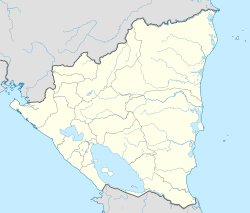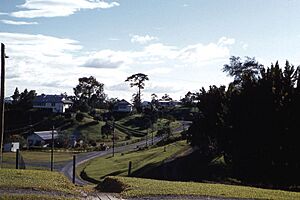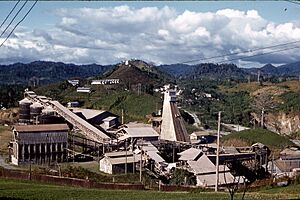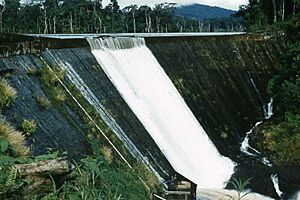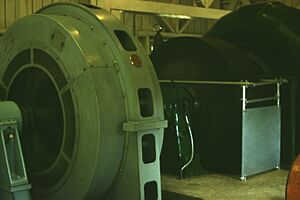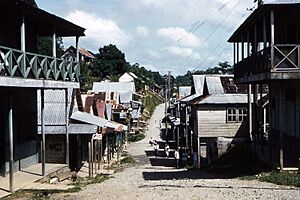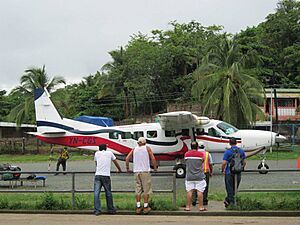Siuna facts for kids
Quick facts for kids
Siuna
|
|
|---|---|
|
Municipality
|
|
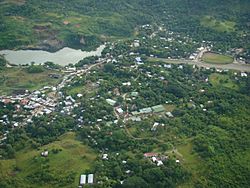
Aerial view of Siuna on the morning of 20 October 2008
|
|
| Country | |
| Department | North Caribbean Autonomous Region |
| Area | |
| • Municipality | 1,321 sq mi (3,422 km2) |
| Population
(2022 estimate)
|
|
| • Municipality | 104,959 |
| • Density | 79.440/sq mi (30.672/km2) |
| • Urban | 24,484 |
| Time zone | UTC-6 (Central Time) |
| • Summer (DST) | UTC-6 (No DST) |
| Climate | Am |
Siuna is a large area in Nicaragua. It is a municipality, which is like a county. Siuna is about 318 kilometers (198 miles) northeast of Managua, the capital city. It is also 218 kilometers (135 miles) west of Puerto Cabezas, a city on the coast. Siuna is part of the North Caribbean Autonomous Region (RACN).
The name Siuna refers to both the main city and the larger municipality. The municipality includes 204 small rural communities and 20 neighborhoods. Many of these places grew because of gold mining along the Ei River. This mining caused the population to grow very quickly starting in the mid-1930s.
Contents
People and Communities in Siuna
The Siuna municipality has a population of over 100,000 people. About 22% of these people live in the city of Siuna. The other 78% live in the more than 200 rural communities.
Siuna has 20 neighborhoods. Many of these neighborhoods used to have names based on the groups of people who lived there during the mining boom. For example, "Moskitown" was where the Miskito people lived. "Jamaicatown" was for the Creole people. Today, all neighborhoods have Spanish names, but the old names are still sometimes used.
Most of the people in Siuna are Mestizo. Smaller groups include the Mayangna, Miskito, and Creole people.
Siuna's Past: The Gold Mining Era
The town of Siuna was once home to the La Luz Mining company. This company operated from 1936 to 1968. Many people moved to Siuna from other parts of Nicaragua to work in the gold mine. This included people from the coast and different indigenous groups. The mine closed in 1968 because its power plant was damaged.
Today, Calibre Mining owns the old mine, but it is not active. Another company, HEMCO, operates the only active mine in the nearby town of Bonanza. HEMCO also works in Siuna through a forestry project. This project involves growing teak trees with a company called NORTEAK.
Learning and Education
Siuna has two universities where students can study.
- The URACCAN (Universidad de las Regiones Autónomas de la Costa Caribe Nicaragüense) offers degrees in subjects like farming and local development.
- The Martin Luther University offers a degree in Nursing.
There is also a secondary school run by MINED (the Ministry of Education). The local parish also runs a school for both primary and secondary students.
How Siuna Makes a Living
After the gold mines closed, most people in Siuna became farmers. They mainly grow beans and corn. In recent years, there has been more focus on growing cacao. Cacao is used to make chocolate and can provide extra income. An organization called Cacao RAAN works with local groups to help with cacao and chocolate production.
Service businesses and the schools also provide jobs in the town.
Community Development with Bridges to Community
An organization called Bridges to Community has an office in Siuna. This group works to help communities grow and develop. They focus on education, health, and economic development.
- Education: Bridges to Community helped build a library in the community of Rosa Grande. Now, over 400 students can use the library for reading, research, and studying.
- Health: They worked with the community of Fonseca to build a water project. This project provides clean water to 30 homes, a school, and a chapel. They are also working to fix the water system at the local hospital to make sure it always has water.
Bridges to Community works in a special way. They only help communities that ask for their support. They also work on projects that the community itself wants. This group also believes in connecting people and cultures through service and learning. In 2013, Bridges to Community started working in the community of Tadazna.
Getting Around Siuna
Siuna has an airport called Siuna Airport. You can fly there with Avianca Nicaragua (also known as La Costeña). You can also reach Siuna by bus. One bus route goes from Managua to Puerto Cabezas. Another route goes through Waslala from Matagalpa. The bus ride from Managua to Siuna takes about 12 hours. From Waslala, it takes about 6 hours.
In town, people use taxis and a local bus system to get around.
See also
 In Spanish: Siuna para niños
In Spanish: Siuna para niños


